You are using an out of date browser. It may not display this or other websites correctly.
You should upgrade or use an alternative browser.
You should upgrade or use an alternative browser.
Recently purchased (1 Viewer)
- Thread starter mikemiller1955
- Start date
mikemiller1955
Lieutenant General
- Joined
- Aug 3, 2008
- Messages
- 17,607
Thank you Randy and Captain,
Randy, the rib eyes were great, thank you. You still hoboing on the streets and collecting debris?
Captain, Randy gave me a tip on that snow.
Use a small paint brush to move it around to cover their bases and surround the bottom of the trees. It's a little clingy too.
Michael
Randy, the rib eyes were great, thank you. You still hoboing on the streets and collecting debris?
Captain, Randy gave me a tip on that snow.
Use a small paint brush to move it around to cover their bases and surround the bottom of the trees. It's a little clingy too.
Michael
mikemiller1955
Lieutenant General
- Joined
- Aug 3, 2008
- Messages
- 17,607
French Marines Set SF-02
French marines, accompanied Lagy’s French force and played a part in the defeat of Roger’s Rangers at the Battle On Snowshoes.
Backdrop, courtesy of PolarBear, thank you Randy.
Michael
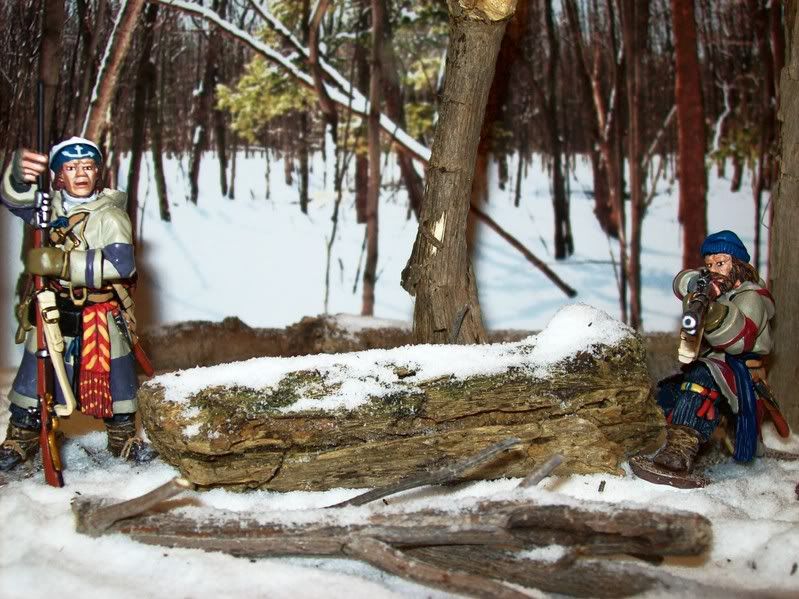
French marines, accompanied Lagy’s French force and played a part in the defeat of Roger’s Rangers at the Battle On Snowshoes.
Backdrop, courtesy of PolarBear, thank you Randy.
Michael

mikemiller1955
Lieutenant General
- Joined
- Aug 3, 2008
- Messages
- 17,607
French Regulars, Regiment de la Reine Set SF-03
A Battalion of the regiment de La Reine formed part of the six battalions of French regular infantry that set out for Canada in 1755. During the voyage from France, four companies of the La Reine and four of the Languedoc were captured when their transport, Ie Lys, was intercepted by the Royal Navy off Newfoundland.
The regiment can be distinguished by the red collar and cuffs, the shape of the pockets, and the pewter buttons. The deep cuffs are trimmed with a row of three large pewter buttons along the edge.
Again, backdrop from Randy.
Michael

A Battalion of the regiment de La Reine formed part of the six battalions of French regular infantry that set out for Canada in 1755. During the voyage from France, four companies of the La Reine and four of the Languedoc were captured when their transport, Ie Lys, was intercepted by the Royal Navy off Newfoundland.
The regiment can be distinguished by the red collar and cuffs, the shape of the pockets, and the pewter buttons. The deep cuffs are trimmed with a row of three large pewter buttons along the edge.
Again, backdrop from Randy.
Michael

mikemiller1955
Lieutenant General
- Joined
- Aug 3, 2008
- Messages
- 17,607
I found this narrative from Captain Robert Rogers, for March 13th, 1758, on the first ambush of the Battle of Snow Shoes.
- We waited until their front was nearly opposite to our left wing, when I fired a gun, as a signal for a general discharge upon them; whereupon we gave them the first fire, which killed about forty Indians, the rest retreated. My party pursued them & Scalped about forty Indians in about one quarter of an hour.
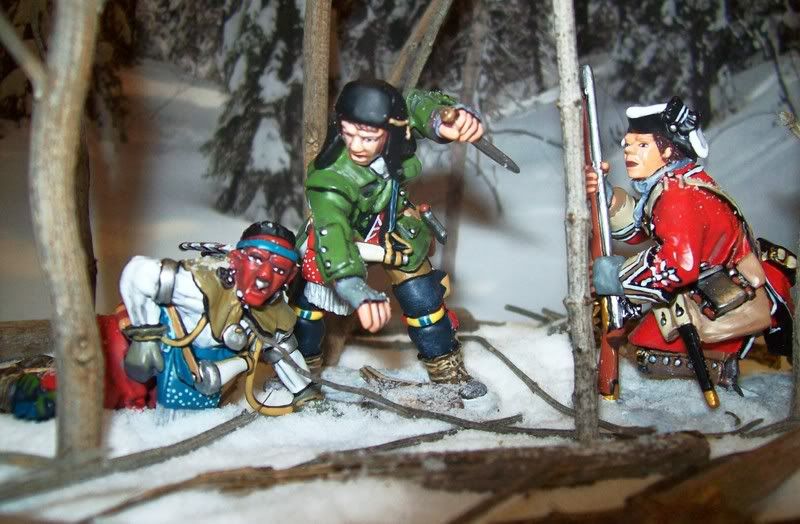
- We waited until their front was nearly opposite to our left wing, when I fired a gun, as a signal for a general discharge upon them; whereupon we gave them the first fire, which killed about forty Indians, the rest retreated. My party pursued them & Scalped about forty Indians in about one quarter of an hour.

mikemiller1955
Lieutenant General
- Joined
- Aug 3, 2008
- Messages
- 17,607
French Marines Set SF-01
After the initial ambush by Robert's Rangers on the 96 chiefly Indians, which started the Battle of Snow Shoes, they in turn were ambushed by the French party following the Indians.
The exultant rangers ran straight into Langy's volley, delivered at close range in total surprise. Captain Bulkeley and all his officers were killed or wounded in the deadly fusillade. Lieutenant Moore and Ensign MacDonald, both mortally wounded, managed to rally the survivors and fall back, hard pressed by Langy and Durantaye to Roger's main body before they died.
This group was comprised mostly of French Marines and Canadian militia and commanded by Sieur De Langy.
Michael
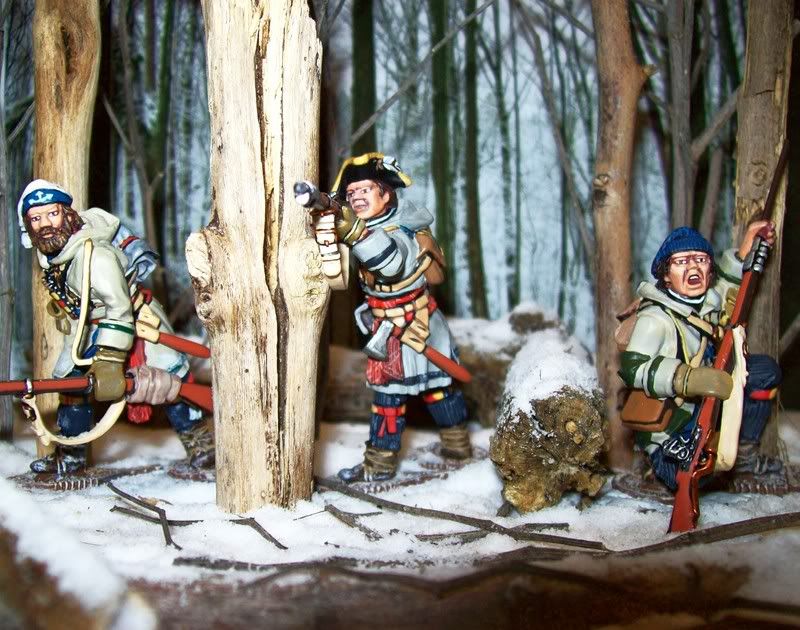
After the initial ambush by Robert's Rangers on the 96 chiefly Indians, which started the Battle of Snow Shoes, they in turn were ambushed by the French party following the Indians.
The exultant rangers ran straight into Langy's volley, delivered at close range in total surprise. Captain Bulkeley and all his officers were killed or wounded in the deadly fusillade. Lieutenant Moore and Ensign MacDonald, both mortally wounded, managed to rally the survivors and fall back, hard pressed by Langy and Durantaye to Roger's main body before they died.
This group was comprised mostly of French Marines and Canadian militia and commanded by Sieur De Langy.
Michael

mikemiller1955
Lieutenant General
- Joined
- Aug 3, 2008
- Messages
- 17,607
Scalps were worth five pounds sterling back at Fort Edward.
The small book The Battle on Snowshores by Bob Bearor, Heritage Books gives the gory details of the battle.
Lenswerks,
In relative terms to current day, what would five pounds equal back then, in your opinion?
One pound now equals about $1.50, so $7.50 roughly for a scalp.
What kind of bounty was $7.50 in 1758?
Was that significant?
Michael
PS...I will buy that book, thank you.
mikemiller1955
Lieutenant General
- Joined
- Aug 3, 2008
- Messages
- 17,607
If you want to read some gory details on the Battle of Snow Shoes, try this link, very vivid and great reading.
Some excerpts from this article by Joseph F. Meany Jr..
Michael
http://www.dmna.state.ny.us/historic/articles/snowshoe.htm
"However Rogers found a resumption of the offensive impossible. "Our number being now too far reduced to take advantage of their disorder, they rallied again, and made a fresh attack upon us." The French and Indians, infuriated by the sight of scalped corpses, victims of the first ambush, threw themselves into repeated assaults and, as casualties continued to mount, Rogers position became more and more precarious."
"Langy and Durantaye were equally determined to finish the rangers before they could break up and escape in the darkness. The final assault came in from all sides but Lieutenant Phillips on the right was the first to be cut off and overwhelmed. He attempted to surrender on terms and did receive assurances of quarter. However, once in enemy hands scalps were discovered on the persons of the survivors and most "were inhumanly tied up to trees" and hacked to death by the enraged Indians."
Some excerpts from this article by Joseph F. Meany Jr..
Michael
http://www.dmna.state.ny.us/historic/articles/snowshoe.htm
"However Rogers found a resumption of the offensive impossible. "Our number being now too far reduced to take advantage of their disorder, they rallied again, and made a fresh attack upon us." The French and Indians, infuriated by the sight of scalped corpses, victims of the first ambush, threw themselves into repeated assaults and, as casualties continued to mount, Rogers position became more and more precarious."
"Langy and Durantaye were equally determined to finish the rangers before they could break up and escape in the darkness. The final assault came in from all sides but Lieutenant Phillips on the right was the first to be cut off and overwhelmed. He attempted to surrender on terms and did receive assurances of quarter. However, once in enemy hands scalps were discovered on the persons of the survivors and most "were inhumanly tied up to trees" and hacked to death by the enraged Indians."
mikemiller1955
Lieutenant General
- Joined
- Aug 3, 2008
- Messages
- 17,607
27th Regiment of Foot Set SB-02
The 27th (Inniskilling) Regiment of Foot was an infantry regiment of the British Army. During the Seven Years' War (1756-63) the Regiment fought against the French in North America. Some also accompanied Rogers and participated in the Battle of Snow Shoes.
Michael
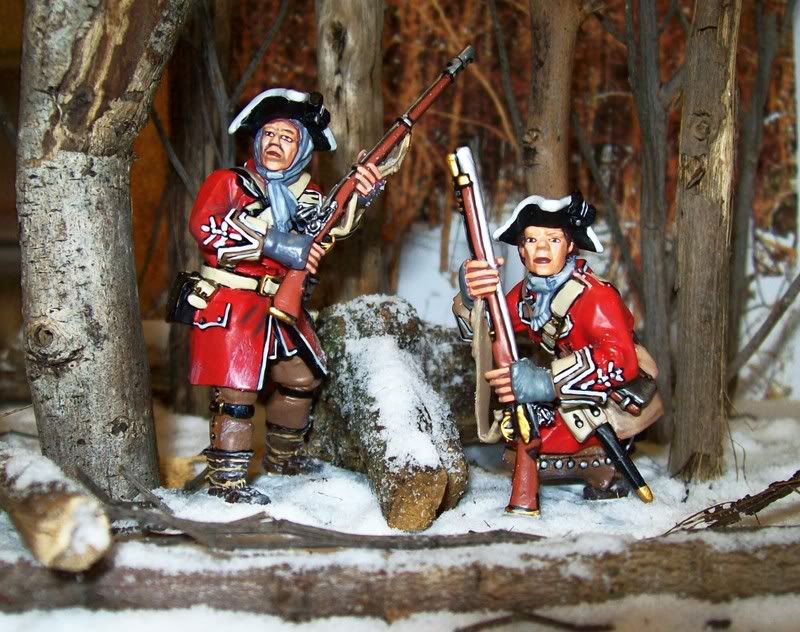
The 27th (Inniskilling) Regiment of Foot was an infantry regiment of the British Army. During the Seven Years' War (1756-63) the Regiment fought against the French in North America. Some also accompanied Rogers and participated in the Battle of Snow Shoes.
Michael

mikemiller1955
Lieutenant General
- Joined
- Aug 3, 2008
- Messages
- 17,607
Roger's Rangers Set SRR-01
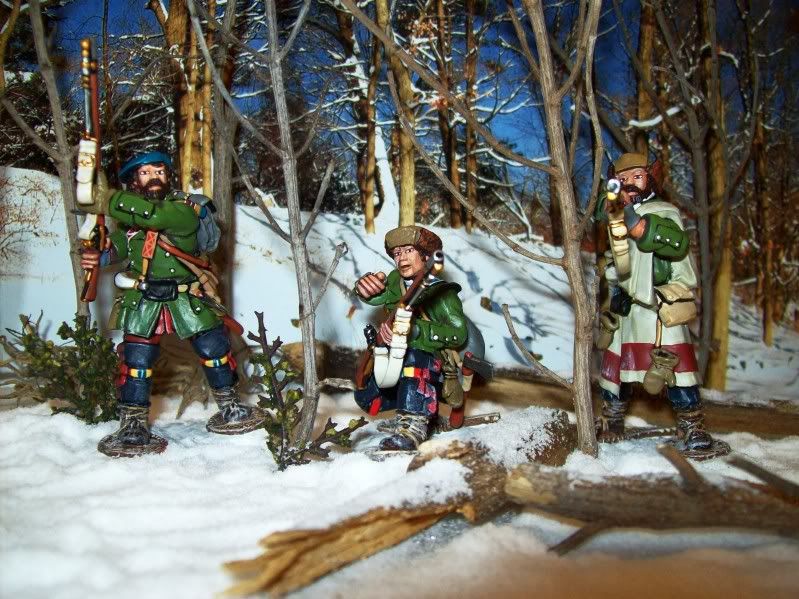
On March 13th 1758 a small battle took place in the wilderness of north America.
The total number on both sides did not exceed 500 men. These men on the British side were primarily native born settlers from New England led by Robert Rogers, and on the French side native born Canadians and their native Indian allies of New France, led by the French partisan Langy.
This battle did not end in a draw. Despite the success of an initial ambush by Rogers and his rangers, the battle was to swing the way of the numerically superior French force.
It was to be a clear cut victory for the French and Indians and resulted in the almost total annihilation of the best of the newly formed English Rangers.
Only darkness was to save Rogers and the remnants of his force.
Michael

On March 13th 1758 a small battle took place in the wilderness of north America.
The total number on both sides did not exceed 500 men. These men on the British side were primarily native born settlers from New England led by Robert Rogers, and on the French side native born Canadians and their native Indian allies of New France, led by the French partisan Langy.
This battle did not end in a draw. Despite the success of an initial ambush by Rogers and his rangers, the battle was to swing the way of the numerically superior French force.
It was to be a clear cut victory for the French and Indians and resulted in the almost total annihilation of the best of the newly formed English Rangers.
Only darkness was to save Rogers and the remnants of his force.
Michael
mikemiller1955
Lieutenant General
- Joined
- Aug 3, 2008
- Messages
- 17,607
Roger's Rangers Set SRR-02
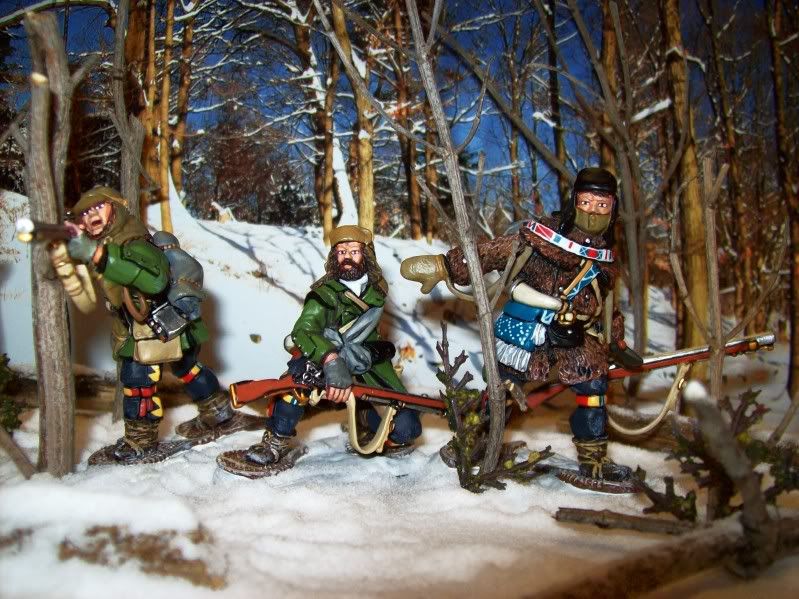
Roger's narrative, March 13, 1758
We kept close to the mountain, that the advanced guard might better observe the rivulet, on the ice of which I imagined the enemy would travel if out, as the snow was four feet deep, and very bad travelling on snow shoes.
In this manner we marched a mile and a half, when our advanced guard informed me of the enemy being in their view; and soon after, that they had ascertained their number to be 96 chiefly Indians. We immediately laid down our packs, and prepared for battle, supposing these to be the whole number or main body of the enemy, who were marching on our left up the rivulet, upon the ice, and would come within 15 Rods of my party by the course they then steered.
I orderd Ensign [Gregory] McDonald to the command of the advance guard, which, as we faced to the left, made a flanking party to our right. We marched to within a few yards of the bank, which was higher than the ground we occupied; and observing the ground gradually to descend from the bank of the rivulet to the foot of the mountain, we extended our party along the bank for enough to command the whole of the enemies at once.
We waited until their front was nearly opposite to our left wing, when I fired a gun, as a signal for a general discharge upon them; whereupon we gave them the first fire, which killed about forty Indians, the rest retreated. My party pursued them & Scalped about forty Indians in about one quarter of an hour.
Michael

Roger's narrative, March 13, 1758
We kept close to the mountain, that the advanced guard might better observe the rivulet, on the ice of which I imagined the enemy would travel if out, as the snow was four feet deep, and very bad travelling on snow shoes.
In this manner we marched a mile and a half, when our advanced guard informed me of the enemy being in their view; and soon after, that they had ascertained their number to be 96 chiefly Indians. We immediately laid down our packs, and prepared for battle, supposing these to be the whole number or main body of the enemy, who were marching on our left up the rivulet, upon the ice, and would come within 15 Rods of my party by the course they then steered.
I orderd Ensign [Gregory] McDonald to the command of the advance guard, which, as we faced to the left, made a flanking party to our right. We marched to within a few yards of the bank, which was higher than the ground we occupied; and observing the ground gradually to descend from the bank of the rivulet to the foot of the mountain, we extended our party along the bank for enough to command the whole of the enemies at once.
We waited until their front was nearly opposite to our left wing, when I fired a gun, as a signal for a general discharge upon them; whereupon we gave them the first fire, which killed about forty Indians, the rest retreated. My party pursued them & Scalped about forty Indians in about one quarter of an hour.
Michael
mikemiller1955
Lieutenant General
- Joined
- Aug 3, 2008
- Messages
- 17,607
27th Regiment of Foot British Regular Infantry Set SB-03
Some of the 27th soldiers accompanied the Rangers on this raid mission.
Following the Indians that they had ambushed, and not far behind, was a large contingent of their French allies.
The veteran French officer Langy, hearing the firing to his front, deployed his two hundred and five men, mostly French marines and Canadian militia, and advanced in a rough line of battle.
Within minutes Langy's force received the approximately fifty-five fleeing survivors of Durantaye's force hotly pursued by Ensign Gregory MacDonald's right flank guard followed by virtually the whole of Captain Charles Bulkeley's division including lieutenants Increase Moore, Archibald Campbell, James Pottinger and Ensign James White.
The exultant rangers ran straight into Langy's volley, delivered at close range in total surprise. Captain Bulkeley and all his officers were killed or wounded in the deadly fusillade. Lieutenant Moore and Ensign MacDonald, both mortally wounded, managed to rally the survivors and fall back, hard pressed by Langy and Durantaye, to Roger's main body before they died.
Rogers himself was unable to form the remaining rangers into line facing the attacking French and Indians.
Some rangers were caught scalping and searching the dead at the first ambush site, others were scattered through the woods where they had followed Bulkeley's men in pursuit of the defeated Indians. Now as the French counter-attack came in on his right, Rogers found his flank turned and himself in danger of being enveloped.
Rogers, a superb combat leader, was nothing if not mentally and emotionally resilient. He took in the chaotic situation and made his decision in a moment, ordering the rangers to fall back toward the high ground of Bald Mountain. If he could not break contact he would make his stand there.
Thus ended phase two of the battle. Phase three, the rangers "last stand" was about to begin.
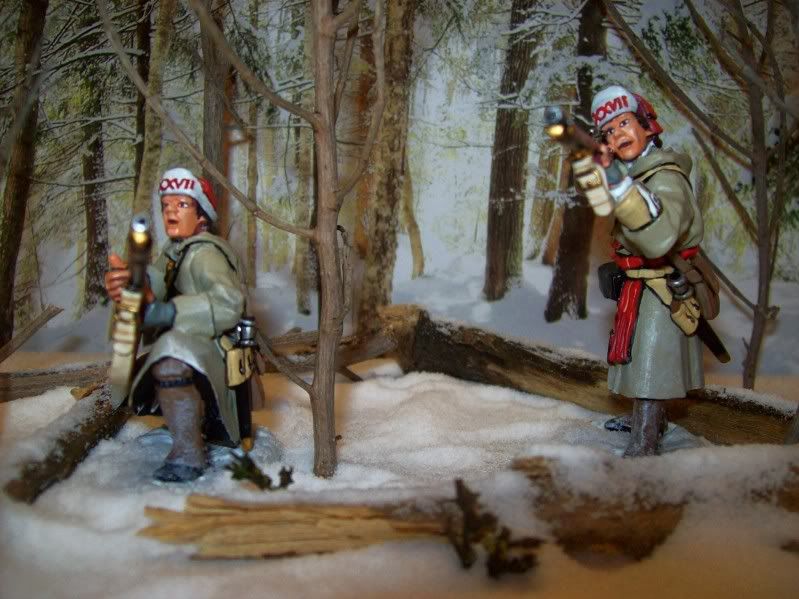
Some of the 27th soldiers accompanied the Rangers on this raid mission.
Following the Indians that they had ambushed, and not far behind, was a large contingent of their French allies.
The veteran French officer Langy, hearing the firing to his front, deployed his two hundred and five men, mostly French marines and Canadian militia, and advanced in a rough line of battle.
Within minutes Langy's force received the approximately fifty-five fleeing survivors of Durantaye's force hotly pursued by Ensign Gregory MacDonald's right flank guard followed by virtually the whole of Captain Charles Bulkeley's division including lieutenants Increase Moore, Archibald Campbell, James Pottinger and Ensign James White.
The exultant rangers ran straight into Langy's volley, delivered at close range in total surprise. Captain Bulkeley and all his officers were killed or wounded in the deadly fusillade. Lieutenant Moore and Ensign MacDonald, both mortally wounded, managed to rally the survivors and fall back, hard pressed by Langy and Durantaye, to Roger's main body before they died.
Rogers himself was unable to form the remaining rangers into line facing the attacking French and Indians.
Some rangers were caught scalping and searching the dead at the first ambush site, others were scattered through the woods where they had followed Bulkeley's men in pursuit of the defeated Indians. Now as the French counter-attack came in on his right, Rogers found his flank turned and himself in danger of being enveloped.
Rogers, a superb combat leader, was nothing if not mentally and emotionally resilient. He took in the chaotic situation and made his decision in a moment, ordering the rangers to fall back toward the high ground of Bald Mountain. If he could not break contact he would make his stand there.
Thus ended phase two of the battle. Phase three, the rangers "last stand" was about to begin.

mikemiller1955
Lieutenant General
- Joined
- Aug 3, 2008
- Messages
- 17,607
Woodland Indians Set SWI-02
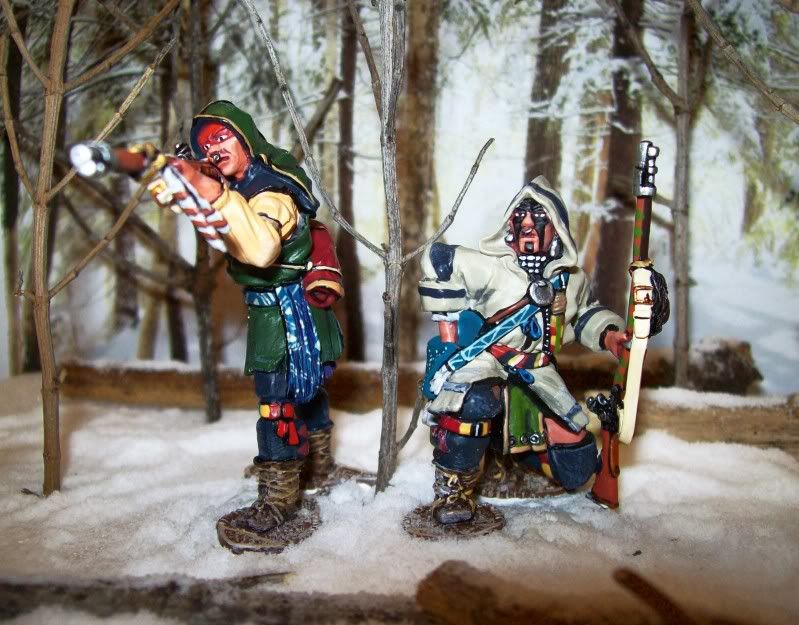
The French and Indians, perhaps seeing that the destruction of Rogers' hated rangers was at last within their grasp, pressed their attack so closely that the rangers could not break contact. Rogers later wrote in his journal that he lost fifty men in getting to the high ground.
"The remainder I rallied, and drew up in pretty good order, where they fought with such intrepidity and bravery as obliged the enemy to retreat a second time; but we not being in a condition to pursue them, they rallied again, and recovered their ground, and warmly pushed us in front and both wings, while the mountain defended our rear."
Loescher, the historian of Rogers Rangers, estimates that Rogers now had not more than 120 men, many wounded, on his firing line. Ensign Joseph Waite and the ten men of his rear guard, on the left, were cut off and overwhelmed in the confusion as the rangers scrambled up toward the high ground. The officer and one man succeeded in escaping the carnage and fled into the woods.
The French and Indians, well handled by Langy and Durantaye, pressed the rangers on all sides and attempted to envelop the perimeter around both flanks. The rangers' position held, however, and "they were so warmly received that their flanking parties soon retreated to their main body with considerable loss. This threw the whole again into disorder, and they retreated a third time."
However Rogers found a resumption of the offensive impossible. "Our number being now too far reduced to take advantage of their disorder, they rallied again, and made a fresh attack upon us."
The French and Indians, infuriated by the sight of scalped corpses, victims of the first ambush, threw themselves into repeated assaults and, as casualties continued to mount, Rogers position became more and more precarious.
Most of the Indians seemed concentrated on the English right where, under Lieutenant William Phillips, the perimeter was first strained to the breaking point. But soon Rogers, who had now been in action about an hour and a half, was patching and filling everywhere.
"Lieutenant Phillips informed me that about 200 Indians were going up ye hill on our right to take possession of ye rising ground upon our backs. . . I ordered him with 18 Men to take possession of ye rising Ground before the Enemy, & try to beat them back. Accordingly he went, but I being Suspicious that ye Enemy would go round on our left & take possession of the other part of the hill, I sent Lieutenant [Edward] Crofton with 15 Men to take possession of the ground there and soon after desired Captain Pringle to go with a few men & assist Crofton, which he did with Lt. Roche & 8 Men. But the Enemy pushed so close in the front that the party's were not more than 20 yards apart & oftentimes intermixed with each other."
Michael

The French and Indians, perhaps seeing that the destruction of Rogers' hated rangers was at last within their grasp, pressed their attack so closely that the rangers could not break contact. Rogers later wrote in his journal that he lost fifty men in getting to the high ground.
"The remainder I rallied, and drew up in pretty good order, where they fought with such intrepidity and bravery as obliged the enemy to retreat a second time; but we not being in a condition to pursue them, they rallied again, and recovered their ground, and warmly pushed us in front and both wings, while the mountain defended our rear."
Loescher, the historian of Rogers Rangers, estimates that Rogers now had not more than 120 men, many wounded, on his firing line. Ensign Joseph Waite and the ten men of his rear guard, on the left, were cut off and overwhelmed in the confusion as the rangers scrambled up toward the high ground. The officer and one man succeeded in escaping the carnage and fled into the woods.
The French and Indians, well handled by Langy and Durantaye, pressed the rangers on all sides and attempted to envelop the perimeter around both flanks. The rangers' position held, however, and "they were so warmly received that their flanking parties soon retreated to their main body with considerable loss. This threw the whole again into disorder, and they retreated a third time."
However Rogers found a resumption of the offensive impossible. "Our number being now too far reduced to take advantage of their disorder, they rallied again, and made a fresh attack upon us."
The French and Indians, infuriated by the sight of scalped corpses, victims of the first ambush, threw themselves into repeated assaults and, as casualties continued to mount, Rogers position became more and more precarious.
Most of the Indians seemed concentrated on the English right where, under Lieutenant William Phillips, the perimeter was first strained to the breaking point. But soon Rogers, who had now been in action about an hour and a half, was patching and filling everywhere.
"Lieutenant Phillips informed me that about 200 Indians were going up ye hill on our right to take possession of ye rising ground upon our backs. . . I ordered him with 18 Men to take possession of ye rising Ground before the Enemy, & try to beat them back. Accordingly he went, but I being Suspicious that ye Enemy would go round on our left & take possession of the other part of the hill, I sent Lieutenant [Edward] Crofton with 15 Men to take possession of the ground there and soon after desired Captain Pringle to go with a few men & assist Crofton, which he did with Lt. Roche & 8 Men. But the Enemy pushed so close in the front that the party's were not more than 20 yards apart & oftentimes intermixed with each other."
Michael
mikemiller1955
Lieutenant General
- Joined
- Aug 3, 2008
- Messages
- 17,607
Woodland Indians Set SWI-01
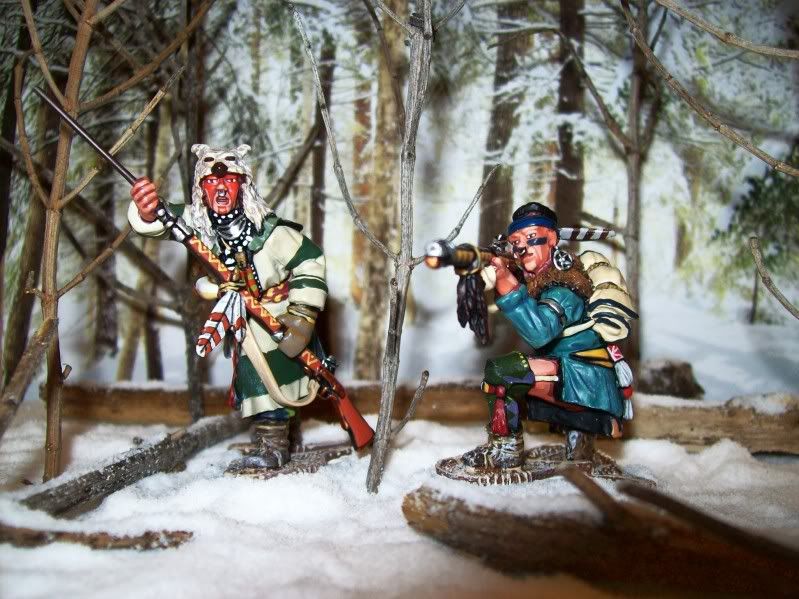
Darkness was now approaching and Rogers, having lost eight of fourteen officers and over 100 men, sought only to hang on until nightfall. Rogers himself with Ensign Joseph Waite held the center with some thirty-one men still effective. Phillips held the right flank with eighteen men, not nearly enough, while Crofton and Pringle held the left with twenty-three.
Langy and Durantaye were equally determined to finish the rangers before they could break up and escape in the darkness. The final assault came in from all sides but Lieutenant Phillips on the right was the first to be cut off and overwhelmed.
He attempted to surrender on terms and did receive assurances of quarter. However, once in enemy hands scalps were discovered on the persons of the survivors and most "were inhumanly tied up to trees" and hacked to death by the enraged Indians.
Only Phillips and three others survived. They were eventually taken north where they were paraded and exhibited as "live letters" through the Indian villages around Montreal. After a series of harrowing experiences, Phillips, the only ranger officer captured alive, escaped and made his way back to British lines. The fate of the other three MIA's is unknown but can be surmised. They never returned to New England.
As the rangers dispersed into the gathering gloom Rogers threw off his uniform coat which was later discovered on the battlefield by the French. In the pocket was found his captain's commission, dated 24 March 1756 and signed by Sir William Shirley.
The French were briefly convinced that Rogers was indeed among the dead. One Iroquois warrior later boasted to Governor Vaudreuil that "he had himself killed him."
Rogers actually made good a legendary escape, supposedly climbing up the west slope of Bald Mountain and then sliding down the smooth, frozen, near vertical, east face of the mountain to the surface of Lake George over a thousand feet below. Loescher suggests that he back-tracked to the lip of the cliff in order to convey the impression to his pursuers that he had actually used "Roger's Slide." Rogers does not mention his escape, saying only that "the Indians closely pursuing us at the same time, took several prisoners."
The defeated rangers trickled into Fort Edward in small groups from about 3 p.m. Rogers, bringing up the rear, reached the fort about 5 p.m. He had brought with him fifty-two survivors, eight badly wounded. He had lost 124 men and one more, his own orderly, died of the cold during the retreat.
Michael

Darkness was now approaching and Rogers, having lost eight of fourteen officers and over 100 men, sought only to hang on until nightfall. Rogers himself with Ensign Joseph Waite held the center with some thirty-one men still effective. Phillips held the right flank with eighteen men, not nearly enough, while Crofton and Pringle held the left with twenty-three.
Langy and Durantaye were equally determined to finish the rangers before they could break up and escape in the darkness. The final assault came in from all sides but Lieutenant Phillips on the right was the first to be cut off and overwhelmed.
He attempted to surrender on terms and did receive assurances of quarter. However, once in enemy hands scalps were discovered on the persons of the survivors and most "were inhumanly tied up to trees" and hacked to death by the enraged Indians.
Only Phillips and three others survived. They were eventually taken north where they were paraded and exhibited as "live letters" through the Indian villages around Montreal. After a series of harrowing experiences, Phillips, the only ranger officer captured alive, escaped and made his way back to British lines. The fate of the other three MIA's is unknown but can be surmised. They never returned to New England.
As the rangers dispersed into the gathering gloom Rogers threw off his uniform coat which was later discovered on the battlefield by the French. In the pocket was found his captain's commission, dated 24 March 1756 and signed by Sir William Shirley.
The French were briefly convinced that Rogers was indeed among the dead. One Iroquois warrior later boasted to Governor Vaudreuil that "he had himself killed him."
Rogers actually made good a legendary escape, supposedly climbing up the west slope of Bald Mountain and then sliding down the smooth, frozen, near vertical, east face of the mountain to the surface of Lake George over a thousand feet below. Loescher suggests that he back-tracked to the lip of the cliff in order to convey the impression to his pursuers that he had actually used "Roger's Slide." Rogers does not mention his escape, saying only that "the Indians closely pursuing us at the same time, took several prisoners."
The defeated rangers trickled into Fort Edward in small groups from about 3 p.m. Rogers, bringing up the rear, reached the fort about 5 p.m. He had brought with him fifty-two survivors, eight badly wounded. He had lost 124 men and one more, his own orderly, died of the cold during the retreat.
Michael
Jagdpanther
2nd Lieutenant
- Joined
- Jun 17, 2008
- Messages
- 3,154
Great stuff Michael! Makes me wish I started Battle on Snow Shoes range first. Well I still could but I better not.
Last edited:
The Lt.
Memoriam Member
- Joined
- Dec 10, 2006
- Messages
- 9,076
Once again Michael another very nicely done presentation of your newly acquired sets by JJ featuring very well done photos in telling of a story. Not a bad way for me to finish my first cup of coffee. I've really enjoyed all of your show and tells that you've been providing and featured on various thread on the forum. Looking forward to seeing what's headed our way next. By the way we're headed for a real early spring day here in Maine and hope you haven't had to turn on the heat in your neck of the woods.
 ....The Lt.
....The Lt.
Users who are viewing this thread
Total: 2 (members: 0, guests: 2)

